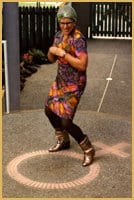
Jackie Heywood
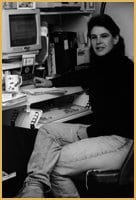
Bet Cecill
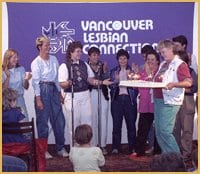
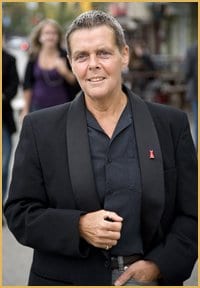
Mary Brookes
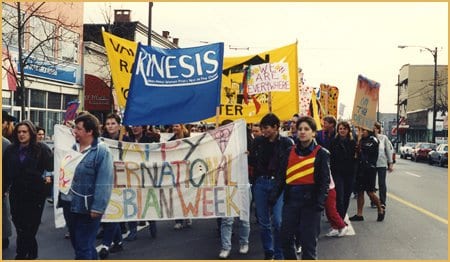
The Drive's earliest dyke marches

Mosaic Creek Park
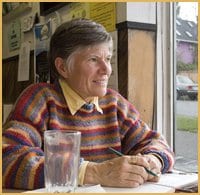
Ellen Woodsworth
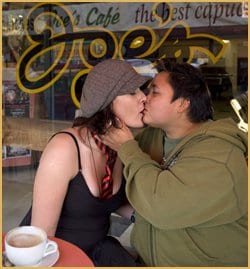
Our cover models commemorate the kiss. Despite repeated calls and trips to the café, Joe could not be reached for comment on the incident.
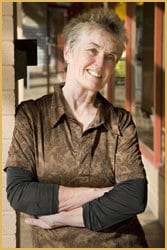
Pat Hogan
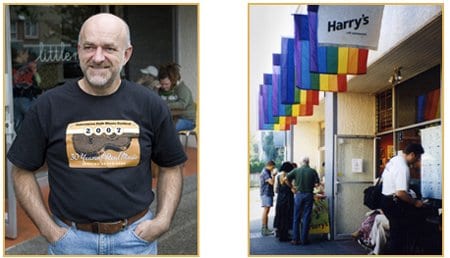
Harry Grunsky Ten rainbow flags flying out front brought traffic screeching to a halt. The concept was a queer place; the slogan, "We're open."
Jackie Crossland (ABOVE RIGHT) says the best coffee and friendliest ambiance on the Drive in the late ’60s and early ’70s was at the Bar Centrale, a coffee bar at 1st Ave and Commercial Dr that was welcoming to women, artists and theatre people.
She still remembers an artist who, in 1977, bought men’s suit vests from thrift stores and sewed elaborate button designs onto them. It was a very popular look. When Crossland attempted her own version of it, someone downtown remarked: “So, is that your East End dyke look?”
Living in a women’s collective in the mid-1970s, Nora D Randall (ABOVE LEFT), remembers taking a break from doing laundry on the Drive to buy a coffee from the Pofi Bar. As she entered the coffee shop the men stopped talking, no one spoke to her, and she left without being served. She persevered and was eventually served on her next visit.
***Under the masthead The Canadian Magazine By Women For People, many of the women who cooperatively produced Makara Magazine from 1975-1978, and worked at the Makara Graphic Design Collective and Daycare, were openly lesbian. Randall, who served as editor, remembers the atmosphere as “so congenial. Great for easy going people like me and Jackie.”
***
Jackie Heywood (LEFT) fondly remembers the women-only Sitka Housing Co-op at 1550 Woodland Dr (RIGHT) as a hotbed of adventure, shouting matches, fantastic parties and vegetarian barbecues. Women came from all over the world to study its model.
Heywood’s comic alter ego, Lovie Sizzle, performed at various events, including a stand-up piece that celebrated making love in a laundromat, to a washing machine.
***
When Bet Cecill (RIGHT) moved to the Drive in 1980, she found lots of dykes. In April 1984, Cecill and four other women formed the Vancouver Lesbian Connection to create a political, service and social organization for lesbian and bisexual women in Vancouver. They encouraged and accepted support from non-lesbians and men. The Vancouver Lesbian Connection soon gave birth to the Vancouver Lesbian Centre at 876 Commercial Dr.
Cecill remembers feeling “scared shitless” at the opening. Fortunately, her fears of a homophobic backlash were not realized; by all accounts it was a tremendous success, the community most welcoming.
The Centre (now home to the Electro LadyLux tattoo studio) sprang from necessity to provide a vibrant space for political discussion, drop-in groups, health information, coming out groups, artwork, poetry readings and performances.
1984 Agreement: That if we share space with another group, the first priority would be another women’s group as opposed to a gay male group.
By 1994, however, the centre was beginning to fall apart.
“After 10 years, I was the only surviving member and completely fried,” says Cecill. “New people lasted about one year. The other original founders had been driven out. It was an ugly mess.”
Harry Grunsky believes the Vancouver Lesbian Centre came undone over the women-born-women issue. Cecill was then a lone voice favouring the inclusion of transwomen. She remembers policy about SM being a huge point of controversy.
***
Mary Brookes (RIGHT) has been on the Drive since 1987. It was “the dyke place to be, a hub of lesbian activity,” she says. Brookes, who now owns Sophie’s Pet Palace, was a key organizer of the Gay Games, an event she says “changed this city and the lives of thousands.”
Working together, Brookes and Bryan Fair then created the Stonewall festival, initially held in the West End. “It was sad,” Brookes recalls. “Vandals turned the toilets over in the middle of the night. The second one, held in Grandview Park, was magnificent. The numbers blew us away. We actually saw gay men from the West End getting off buses on Commercial!”
***The Drive’s earliest dyke marches (BELOW) were empowering, says Mary Brookes. They really pushed people’s buttons, in a time pre-dating city permits or police protection. She remembers blocking traffic, hearing someone spit and mutter “fucking dykes,” and feeling the heat from a bus on her leg.
***Another key organizer of The Lesbian Centre, Cynthia Brooke arrived on the Drive in 1982. “We were all hungry then, there were no lesbians of privilege,” she recalls. Brooke and her business partner Bonnie Murray purchased a used bookstore, the Book Mantel and moved it to the Drive in 1988.
As financial and other difficulties forced the Lesbian Centre to close, The Book Mantel filled a niche and grew into an unofficial lesbian information centre. With the first coffee bar in a BC bookstore, the Book Mantel was theplace on the Drive to gather. Brooke remembers her diverse clientele as primarily lesbian, followed by gay men, a whole queer assortment, some heterosexual but bent patrons, and even a few Catholic grandmothers.
“The impact of the Book Mantel was huge,” agrees Mary Brookes.
Today, Dutch Girl Chocolates stands in the old Book Mantel spot.
***
Community effort claimed a vacant lot and turned it into Mosaic Creek Park (LEFT). Artists Glen Anderson and Marina Szijarto ran mosaic workshops for a year to teach mosaic making to the neighbours. Landscape architect Sarah White consulted with local children to create a unique play space. Artist carol weaver’s bold and colourful graphic designs heralded International Lesbian Week and the Vancouver International Folk Festival.
***
For years, Joe’s Café was a very popular meeting place for women, despite the prominent photograph of Portuguese dictator Salazar on the wall. Mary Brookes remembers seeing more lesbians gathered here than any other place on the Drive.
Harry Grunsky says Joe was initially more interested in the financial aspects of his business, and paid little attention to his lesbian clientele, who were treating the place as their living room. Ellen Woodsworth (RIGHT) recalls Joe kindly. “Joe gave money to Anita Tremblay Roberts for the women’s soccer team to attend the first Gay Games,” she says.
Then on Sep 16, 1990, an event occurred which still has people divided on its details and importance. Two women kissed.
Bet Cecill says it was a kiss between two friends, a lesbian and a straight woman. Others say the two women were really going overboard, making out. Either way, legend has it Joe kicked them out. “He got really upset,” says Cecill. She believes he’d been getting flak about his clientele from some homophobic neighbours.
Woodsworth feels Joe slipped up, at a time when people felt very strong and very healthy. She was sad; she’d been a patron of Joe’s since 1978. Yet it was exhilarating to know women were standing up for themselves, she says.
Protesters picketed the café. They staged a kiss-in. They mooned customers. It was “our little Stonewall,” says Mary Brookes. An event that just happened at a time when a boil was ready to erupt.
“Some hetero guys who worked for Joe quit over the incident,” Harry Grunsky recalls.
“Some pretty laidback dykes were marching but went back in for coffee,” notes Pat Hogan.
Our cover models commemorate the kiss (RIGHT). Despite repeated calls and trips to the café, Joe could not be reached for comment on the incident.
***
Pat Hogan (RIGHT) moved from Connecticut to Vancouver in 1969. Active in the peace movement, Hogan also began organizing women’s music events with the first and only Womyn’s Music Festival at Brighton Park in 1986. Her Sounds and Furies Productions later ran a five-night, women-only café at the WISE Hall during the 1990 Gay Games. To this day, the WISE Hall hosts many queer events year round.
***Following the Joe’s debacle, the realization of a space for women by women seemed attainable. Hogan opened Josephine’s Cappuccino Bar and Wimmin’s Crafts at 1716 Charles St, kissing distance from Joe’s.
For two years, Hogan hosted a lively and welcoming venue. By all accounts, it was a terrific place to meet, hang out and enjoy the entertainment. But despite a solid crew of volunteers, there were financial difficulties. Hogan closed Josephine’s in 1994. Her Sounds and Furies Productions are still going strong.
***Shortly after Josephine’s closure, Harry Grunsky (BELOW LEFT) opened Harry’s in the same location. Ten rainbow flags flying out front brought traffic screeching to a halt. The concept was a queer place; the slogan, “We’re open.”
“The history of the gay rights movement is the courage of the individual to come out,” says Grunsky. “The achievement of our rights is made of so many personal struggles.”
Harry’s was the first place outside the West End to display AIDS information and distribute free condoms and lube. Other businesses soon followed Harry’s lead, putting up event posters “if Harry had one up.”
Grunsky feels his greatest achievement was helping queer youth, providing food and a space to meet and hold dances.
Though the space has since been home to several more establishments, patrons of the Little Nest, the lively restaurant now at 1716 Charles St, still talk about Harry’s.
Photos and text by James Loewen.
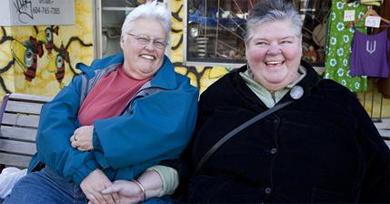
 Why you can trust Xtra
Why you can trust Xtra


